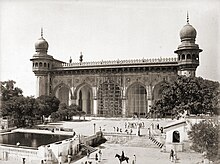Mecca Masjid
| Makkah Masjid مکہ مسجد మక్కా మసీదు |
|
|---|---|

Makkah Masjid
|
|
| Basic information | |
| Location | Hyderabad |
| Geographic coordinates | 17°21′37″N 78°28′24″E / 17.360305°N 78.473416°ECoordinates: 17°21′37″N 78°28′24″E / 17.360305°N 78.473416°E |
| Affiliation | Islam |
| State | Telangana, India |
| Country | India |
| Ecclesiastical or organizational status | Mosque |
| Architectural description | |
| Architectural type | Islamic architecture |
| Architectural style | Qutb Shahi, Asaf Jahi |
| Completed | 1694 |
| Specifications | |
| Capacity | 10,000 |
| Length | 67 m |
| Width | 54 m |
| Height (max) | 23 m |
| Materials | Granite |
Mecca Masjid (Arabic: مسجد مكة, Urdu: مکہ مسجد, Telugu: మక్కా మసీదు), also Makkah Masjid, is one of the oldest mosques in Hyderabad, Telangana in India, and it is one of the largest masajids in India. Makkah Masjid is a listed heritage building in the old city of Hyderabad, close to the historic landmarks of Chowmahalla Palace, Laad Bazaar, and Charminar.
Muhammad Quli Qutb Shah, the fifth ruler of the Qutb Shahi dynasty, commissioned bricks to be made from the soil brought from Mecca, the holiest site of Islam, and used them in the construction of the central arch of the mosque, thus giving the mosque its name. It formed the centerpiece around which the city was planned by Muhammad Quli Qutub Shah.
Makkah Masjid was built during the reign of Muhammad Quli Qutb Shah, the 5th Qutb Shahi Sultan of Golconda (now Hyderabad). The three arched facades have been carved from a single piece of granite, which took five years to quarry. More than 8,000 workers were employed to build the mosque. Muhammad Quli Qutb Shah personally laid the foundation stone. The construction was later completed by Mughal Emperor Aurangzeb after conquering Hyderabad.
...
Wikipedia
